A Beginner's Guide To Proficient SaaS Email Marketing
Email marketing is the most significant digital channel for SaaS companies, as it allows for one-to-one interactions throughout the client journey. Email is the only medium that supports growth across the full sales funnel, integrating all of your marketing efforts together, from lead generation and lead nurturing to customer retention and support.
However, SaaS email marketing is a distinct breed of email marketing. You’re emailing folks who are well-versed in the methods and tactics you’re employing. It implies that we must be as clever with what we deliver as we are with how we deliver it. Most essential, we must be strategic in our approach to learning from our efforts.
We’ll look at the top email marketing strategies for SaaS companies in this guide, which can help you collect more leads, convert them into paying customers, and maximize revenue from everyone who uses your product.
Let’s get started!
What is SaaS email marketing?
The process of advertising a SaaS business through email channels is known as SaaS email marketing. You’re contacting customers at each phase of the customer journey by emails to encourage them to convert to your product in this scenario.
Additional: An SaaS company is a company that manages the servers, databases, and software that enable the program to be accessible via the internet – most commonly through web browsers. The program can be accessed from practically any device.
Customers that use a SaaS program often pay a monthly subscription charge. Some subscriptions are dependent on the amount of data that has to be saved, the number of people that will use the app, or the level of technical support that is required.
For example, AVADA is a SaaS company that provides apps like Marketing Automation or SEO Suite for online eCommerce stores.
The basics of SaaS email marketing
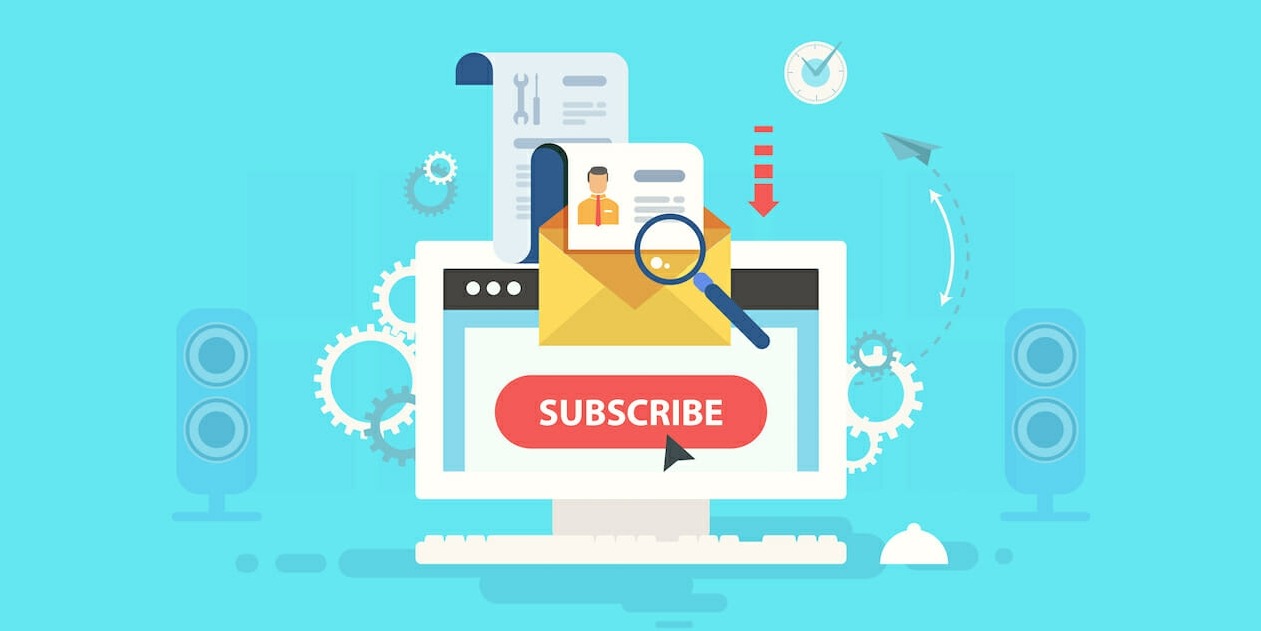
Before we get into email marketing strategies for SaaS marketers, let’s cover the basics first. Here are a few key steps to ensure that your email campaigns for the SaaS company will be successful.
1. Understand your customer journey
Create a customer journey map and a clear understanding of their experience map. Before starting an email marketing flow, how many touchpoints does someone have? What can they expect to happen during and after this specific flow?
The more processes you can identify, the better you’ll be able to comprehend how your email marketing funnel works. The purpose of these emails is to take your leads down the funnel, through the sale, and into retention, which is something that many people neglect.
A good way to do this is by segmenting your customers to make your campaigns effective. Some possible ways to segment your customers include:
-
Behavioral: This refers to how your customers interact with your product.
-
Demographic: Age, gender, wealth, education, and other characteristics of your customers.
-
Psychographic: Information on your clients’ psychology, such as their interests, opinions, values, motives, and attitudes.
-
Size: The size of the companies that purchase your product. Larger businesses have different requirements than smaller businesses.
-
Goals: What do you want your customers to get out of your product?
-
Pain points: What obstacles or roadblocks do your customers seek to overcome with your product?
2. Set goal and track KPIs
Since the ultimate goal is to boost conversions and decrease churn, you’ll need to know your current conversion and churn rates and track them throughout the campaign.
However, there are vital SaaS and email marketing indicators to keep track of to see how effectively your approach is functioning at each stage of the campaign.
KPIs that are essential to you or particular to your product may also exist so gather your team to know them. The goal is to figure out what critical measures you can use to see how well you’re doing and whether a particular email, sequence, or tactic is having the desired effect.
You might want to keep track of the following metrics KPIs for SaaS:
-
Churn Rate: The rate at which you lose clients over time (number of churned customers divided by total number of customers).
-
Revenue churn: Which is the rate at which you lose revenue over a period of time (important for helping you identify the most valuable market segments).
-
Conversion Rate From Freemium To Premium: The percentage of freemium customers who upgrade to premium programs.
-
Average Client Lifetime: The average length of time a customer remains with your company.
-
Customer Retention Rate: The percentage of customers kept by your company over time.
Then, convert these KPIs into metrics that you can use for your email marketing campaigns, such as open rate, click-through rate, and unsubscribe rate.
3. Build emails for users of each stage
It’s time to figure out how to use email marketing campaigns to assist them through the stages of the sales cycle.
You should determine an action you want clients to perform at each stage of the email marketing funnel to drive them to the next stage. What actions should users complete during onboarding to ensure they’re ready to go? Is it necessary for them to create a profile? Is it necessary for them to upload their email list? Is it necessary for them to include a tracking code on their website?
They must perform those steps before moving on to the next stage of your email marketing funnel.
You should track how effective your emails are at getting users to do the desired actions and experiment with different actions at each stage to discover which are the most effective at moving people through the funnel.
This, too, is unique to your product and customers. However, leveraging consumer data is the most effective way to identify these acts.
For example, you should examine your customer behavior data to see if there are any behavioral patterns among freemium users who upgrade to a premium plan. Compare that to freemium users that unsubscribe.
4. Strategize your email marketing effort
It’s unlikely that you’ll come up with the ideal email marketing approach right away.
Trial and error, as well as optimization, are the keys to success.
You’ll need to design tailored emails and tactics based on the information you’ve gathered about your consumer groups in order to move them down the funnel.
Then, depending on where customers are in the funnel, put those strategies into automated email sequences. Time-based or trigger-based email sequences are both possible with a good email marketing software.
Now we’ve got the basics, we can start looking at SaaS email marketing strategies to improve our client flows and guarantee your business the best chance to increase revenue.
4 SaaS email marketing strategies
Now, let’s look at some common SaaS email marketing strategies that you can employ for your company.
1. Email automation strategy

First and foremost, we’ll look at email automation tactics that will enable you to manage more prospects with your current resources. This is critical for automating growth, maximizing efficiency, and avoiding bottlenecking expansion due to resources.
We have four core elements of email automation strategies, which are:
1.1. Drip campaigns
Drip campaigns are email sequences that send out emails at predetermined intervals over time. Assume you’re offering a 30-day free trial to generate interest in your program. When a person joins up for your app, they go through the onboarding process and begin using it, but your objective is to convert them into paying customers.
So you might set up a drip campaign that sends out recommendations every few days to assist them get the most out of your software, and then start emphasizing the benefits of upgrading to a paid plan in the final week of their trial. You should also notify them before their trial time ends, and encourage them to upgrade if they wish to continue using your software.
Drip campaigns are static sequences. As a result, you pre-define the messages that will be sent out as well as the intervals between them, and they will be sent out as soon as the trigger action is executed.
Drip campaigns are also effective for SaaS organizations in the following situations:
-
Customer service: When your support team closes an issue, a drip sequence is started asking for comments from customers.
-
Onboarding: If consumers don’t complete the onboarding process the first time, a drip campaign can entice them to try again.
-
Account verification: Drip campaigns can send out follow-up prompts to remind users if they don’t verify their account the first time.
-
Welcome users: Drip campaigns can assist new users in learning how to utilize your software product.
-
Loyalty & rewards: Customers might be rewarded for their loyalty if they continue to utilize your product.
-
Engagement: Drip campaigns can be used to send out periodic content to keep users interested.
-
Dunning: In the event of unsuccessful payments, these drip campaigns remind clients to update their payment information or manually make a payment.
1.2. Autoresponders
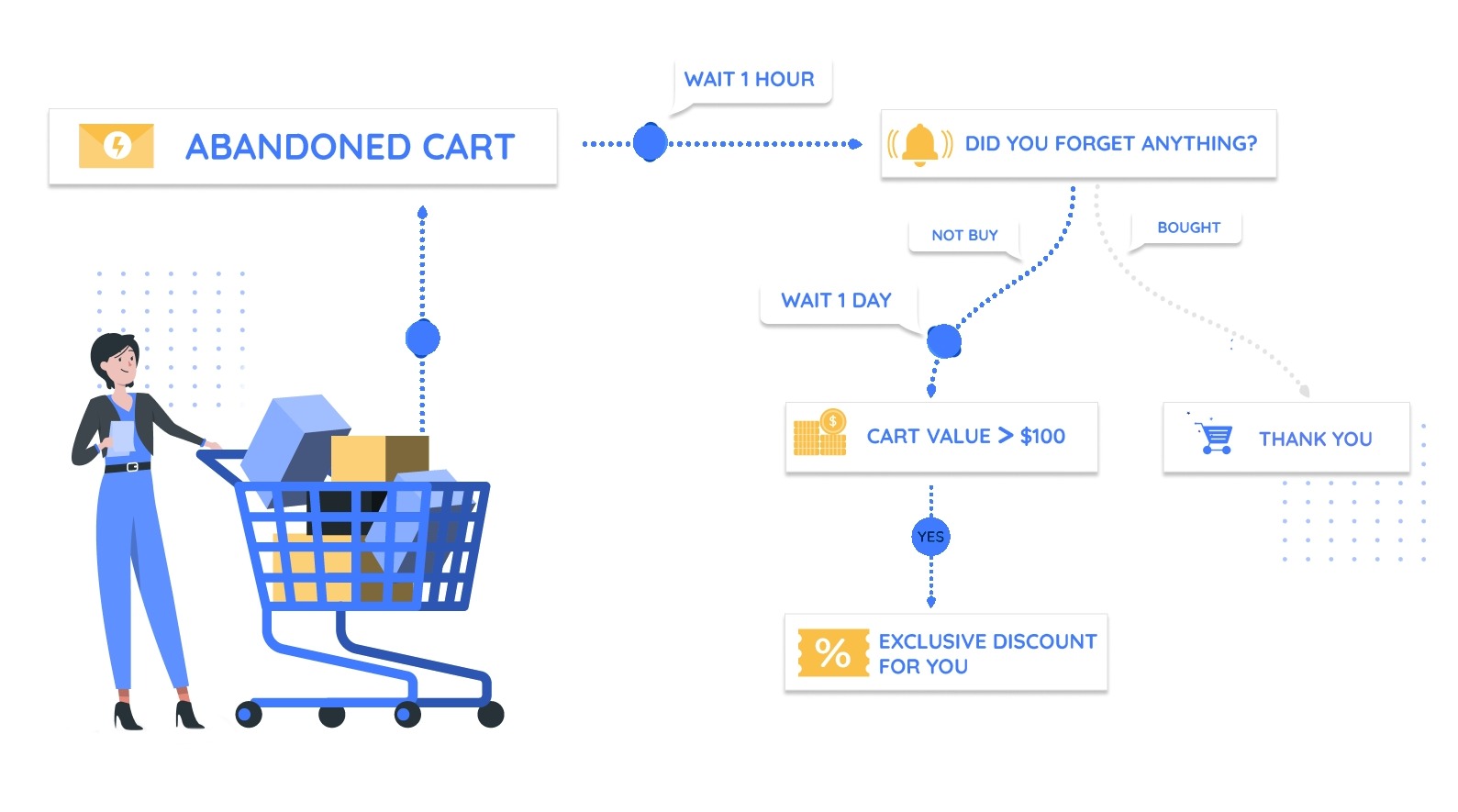
Autoresponders send emails to users automatically once they finish a task. As a result, when a new user registers for a free trial or a client submits a support request, they receive an immediate response in their inbox. This is critical for encounters in which users expect a quick response.
Basic email auto-responses are quite static, with a user taking a specific action that results in a predetermined response — for example, someone submits their email address to download a research paper and is immediately provided a download link.
Customer assistance is another important role that autoresponders play for SaaS organizations. You can connect customers to appropriate support material and other resources before your team is ready to contact them by automating the first interaction when they submit a ticket.
1.3. Personalization
The main issue with marketing automation is that it’s all too simple to lose touch with individual prospects. Email’s fundamental feature as a medium is that it allows you to engage with people one-on-one, but this is tough to maintain at scale.
Fortunately, email marketing is a data-driven strategy, so you can utilize it to personalize your automated emails.
Most email marketing platforms, such as AVADA Marketing Automation, allow you to personalize emails with recipients’ names so you may address them directly, and many also allow you to wish consumers happy birthday.
Beyond the fundamentals of personalisation, SaaS companies have the luxury of having user data to incorporate into the mix. Sending users reports, analytics, and performance statistics indicating how much they’ve accomplished with your product is one of the most effective personalization and engagement techniques.
Personalisation is a significant challenge in terms of maximizing relevance and nurturing meaningful relationships without coming off as creepy. The benefit for SaaS companies is that session data may be used instead of personal information to obtain a better knowledge of each customer’s needs and to send highly targeted email marketing without unwanted reaction.
1.4. Dynamic automation
Advanced workflows are used in dynamic email automation to respond to a variety of user and customer behaviors. Basically, you construct email campaigns for leads and customers at various phases of the consumer journey, as well as audiences with various interests, and then move them from one email list to the next as they complete actions in your sales funnel.
You can, for example, send tailored emails to users based on which pages of your site they visited in order to prioritize the features they use the most. You may utilize session data to move prospects onto lists and incentivize paid upgrades depending on their usage behavior after they sign up for a free trial.
You may also utilize dynamic email automation to classify and score leads/customers in order to prioritize the most valuable prospects for your company.
The most significant email marketing tool for SaaS companies is dynamic email automation, which allows you to develop smart, targeted, and responsive email campaigns that respond to changing interests of your leads and customers.
2. Lead nurturing strategy

We’ll focus on nurturing leads through your sales funnel and converting prospects into paying clients** in the next section. Because capturing quality leads is costly, you must convert as many of them as possible into customers in order to maximize your return on investment.
At every level of the SaaS customer cycle, there are four lead nurturing email tactics to turn prospects into paying customers:
-
Onboarding: To prevent important leads from slipping away during the onboarding stage, guide new users through the sign-up and implementation process.
-
Upselling from free to paid: Converting free users into paying consumers.
-
Funnel campaigns: Leads via your sales and marketing funnels.
-
Customer retention: Make sure your customers continue to pay for your software.
All of these tactics can be implemented by a comprehensive funnel. Which means lead nurturing email campaigns designed to move customers from one stage of the funnel to the next.
To do so with email marketing campaigns, you’ll need to implement a lead generation approach to collect users’ email addresses. This can be difficult at the top of the funnel, when purchase intent is low and persuading consumers to fill out a form and give their personal information is a tall order.
Using free tools to acquire qualified leads and then targeting them with email campaigns asking them to join up for a paid subscription is one of the greatest SaaS lead generation tactics.
3. Engagement strategy
SaaS enterprises must retain clients utilizing their software products and engage with the platform in order to preserve recurring revenue; otherwise, they will leave and your revenue stream will suffer.
Helping clients get the most out of your software product is the best approach to keep them engaged and enthused about using it. So, whatever problem your product addresses, you must assist clients in solving these difficulties to the point where they can no longer live without it.
Your email marketing strategy should include campaigns that strive to give each user the best possible customer experience by offering material that helps them get the most out of your software.
Send them blog entries, guides, and tutorials to help them succeed more, and as they become more comfortable with your platform, increase the intricacy of the guide or the ambition of the goals to help consumers achieve more.
This can also be used in conjunction with upselling campaigns to convince consumers what they can get from upgrading to a more expensive plan.
4. Customer value strategy
We’ll concentrate on** increasing income and client lifetime value in this part**. This begins with persuading consumers to spend more money, but it also includes addressing concerns that may cause them to spend less money or stop using your software altogether.
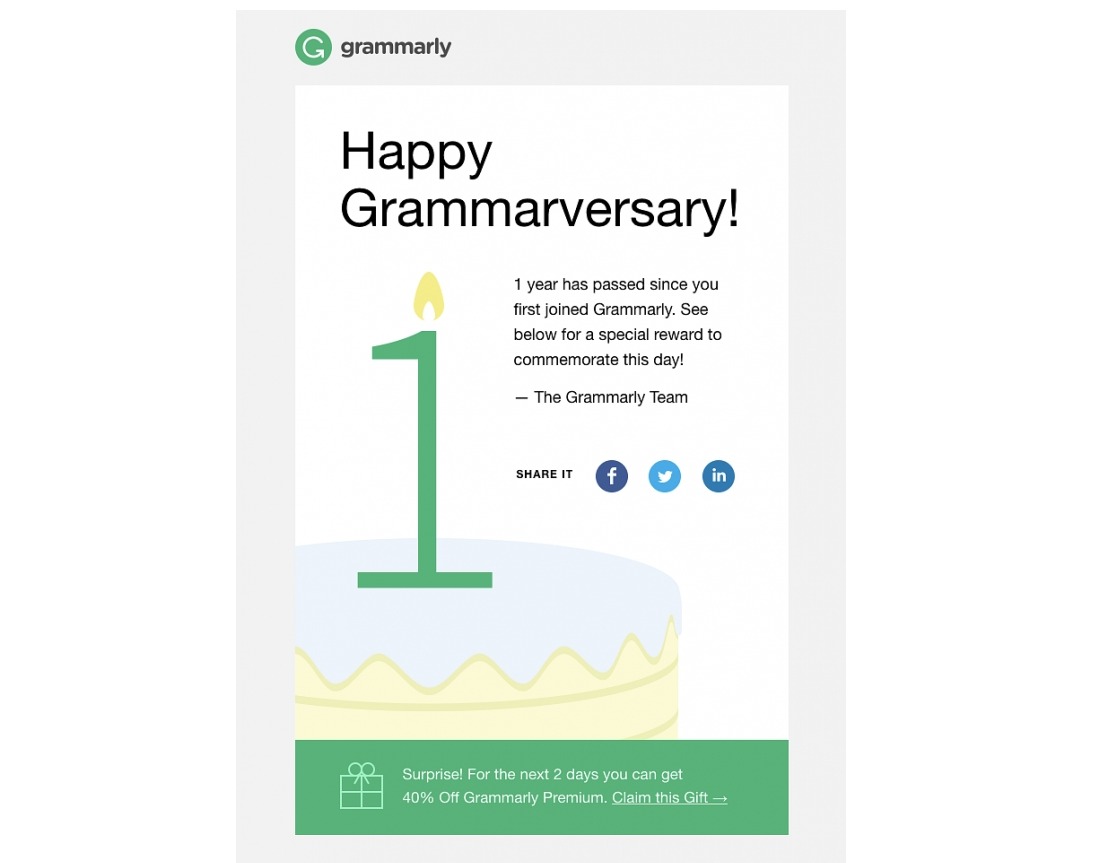
The following email marketing campaigns can be used for this strategy:
-
Upselling and cross-selling: Encourage clients to upgrade to more expensive plans (upselling) and purchase additional products (cross-selling).
-
Re-engagement campaigns: When customers show indications of losing interest, get them to use your product again, respond to emails, and communicate with your brand.
-
Referral campaigns: Ask your current clients to refer new consumers to you.
-
Customer feedback: Collect input from the users who matter the most to improve customer relations and your product.
By re-engaging consumers before they cancel their subscription and fixing any issues that could lead to future churn, you can maximize income from every user, acquire new customers, and reduce churn with these four kinds of campaigns.
SaaS email marketing best practices

With top-notch email marketing best practices, you can increase engagement and generate more revenue for your SaaS company. They won’t be hard to implement, too. All these best practices are perfect for any size of business.
Spend time understanding your subscriber
You’ll be better able to meet your subscribers’ demands if you know who they are (beyond their name and email address). This is comparable to your buyer persona, except it’s specifically for your email subscribers.
To have a deeper understanding of your subscribers, follow these guidelines:
-
Look into where they came from: Did they subscribe to your newsletter as a result of a blog post? Or even a lead magnet? Which one, if any, is it? This enables you to comprehend their problems. Google Analytics may be used to track email and link clicks.
-
Send surveys: The easiest way to find out who has signed up for your emails is to send questionnaires.
-
Keep track of the emails they open and respond to: The emails they open and respond to reveal their interests and pain issues. Check which links they click on as well.
Always use branding when you can
Customers connect with multiple personnel (sales, engineering team, support team, etc.) in your organization via email during the SaaS buyer experience. To establish authority and credibility, make sure to adopt proper SaaS branding principles.
That means your SaaS brand should have a consistent tone. If you employ a formal tone in your emails, for example, make sure the rest of the business does as well. That way, the tone, or voice, of the emails sent to the consumer remains similar, regardless of who sends them.
In addition, make sure that all email signatures are consistent across the organization. You can use AVADA Marketing Automation to set up a global signature for your entire organization.
Allow subscribers to change their preferences
You accomplish two objectives by allowing subscribers to fine-tune their preferences:
-
First, the rate of engagement will rise since they will only receive emails that are relevant to them.
-
Second, you have a deeper understanding of their pain areas, allowing you to personalize your content to their needs and enhance conversion rates.
So, make sure that your subscribers have the option to choose the type of emails and information that they want to receive from you through emails.
Take care of inactive subscribers as well
Don’t give up too soon on inactive subscribers! They may not require your product right soon, but they have expressed interest in it in the past. As a result, put up the effort to (re)establish a relationship with them, and they may decide to buy from you in the future.
Here are a few ideas for reactivating inactive subscribers:
-
In the subject line of your email, ask a query like, “Are we still friends?” “Hey [name], are we breaking up?” or “Hey [name], are we breaking up?” Please tell me no!” You may boost response rates by employing smart copywriting tactics.
-
To motivate people to re-subscribe to your product, provide limited-time discounts.
-
Remind users why they originally signed up for your email. Give them a reason to read and respond to your emails.
-
Send them a survey or questionnaire to find out why they aren’t responding to your communications.
-
Examine the subscribers’ previous behavior and purchases to learn about their preferences and adapt information to them.
SaaS email marketing examples
Next up, let’s look at some SaaS email marketing examples so you know what the pros in the field are doing with their emails.
Zoho
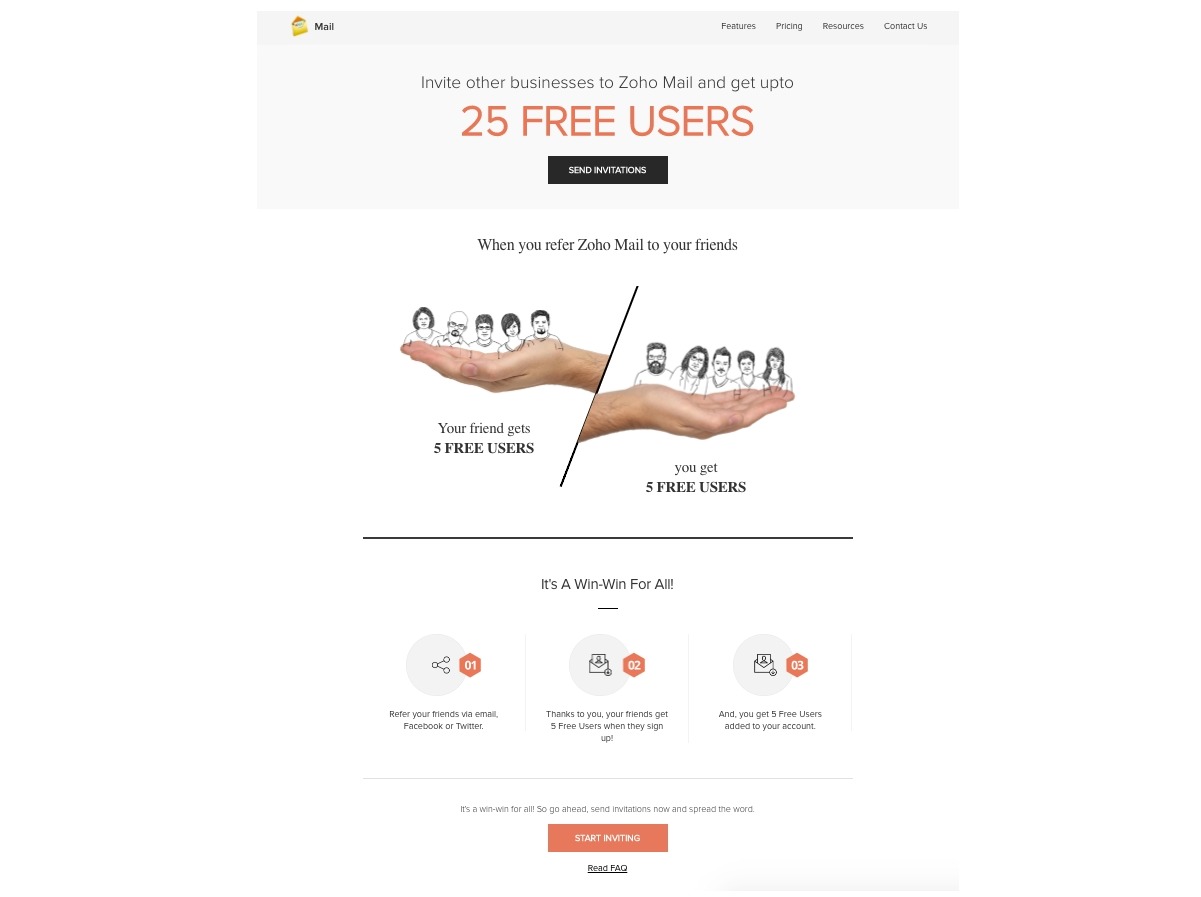
Referral campaigns are an underappreciated method of reaching out to new audiences and increasing your brand financially. You can execute a successful campaign at multiple stages of the client journey if your messaging is well-structured.
Zoho uses this strategy by sending an email to users - letting them know they can increase the number of users by 5 by simply referring the app to 5 more people. The email is well designed, too, with the message being clear and a concentrated CTA button.
Dropbox
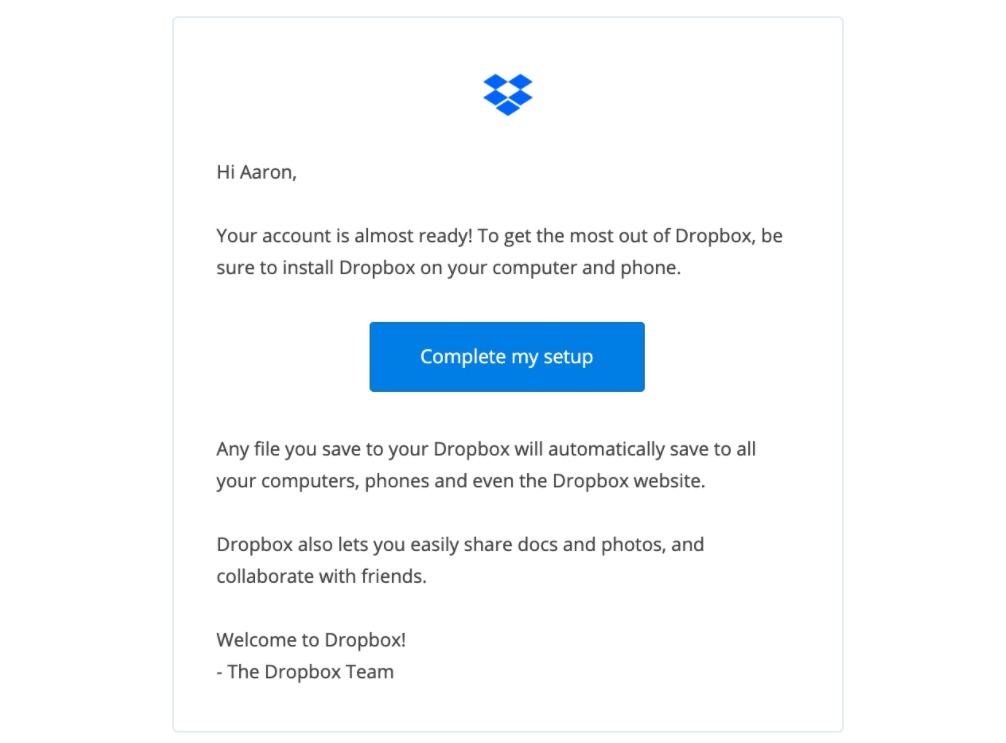
A first interaction with your customer should look like this onboarding email from Dropbox. An instant onboarding email urging users to “complete my setup,” which assists them in setting up an account, encourages them to download the desktop and mobile apps, and provides a slight nudge to upgrade to a subscription plan.
Evernote

Evernote’s upselling email, with an unique offer incentive, inviting consumers to sign up for the Premium or Plus plan. This email example has all the things you can learn, from good graphics to urging elements. However, I would prefer them to point out the “very limited time” by a real clock.
These are only a few of the examples for SaaS email marketing. The best way to learn is that you should try subscribing to them by yourself (especially if they have a free plan) to see how they nurture their users through email campaigns.
Final words
That’s it for my SaaS email marketing guide. All of the information in this article should give you a good place to start planning an email marketing plan for your SaaS business. But don’t forget to leave some room for experimentation with each of your campaigns.
A good email marketing app would be a good helping hand, so feel free to try out our app - AVADA Marketing Automation. As a SaaS company ourselves, our app knows the templates and automations that your company needs to keep users engaged and have them all inside. Better yet, you can try the app for free, no charge included.
Also, you can sign up for our email newsletter, and we can learn more about email marketing together.
New Posts

How To Set Up Google Analytics 4 For Your BigCommerce Store






